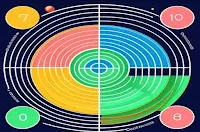In the world of statistics and data science, understanding probability distributions is fundamental. These distributions, like the normal, binomial, and Poisson distributions, elucidate the likelihood of various outcomes. While comprehending these distributions is pivotal, the calculations involved can be intricate. This is where a Probability Distributions Calculator becomes an indispensable tool, simplifying complex mathematical computations and empowering individuals to analyze and interpret data efficiently.
Statistics
The Essence of Probability Distributions
Grasping the Basics
Probability distributions serve as mathematical functions that describe potential outcomes and their probabilities in a given scenario. They offer insights into the likelihood of different results within a dataset, laying the groundwork for statistical analyses and predictive modeling.
- Normal Distribution:
- Characterized by a bell-shaped curve, the normal distribution is ubiquitous in various fields. It highlights the symmetric nature of many natural phenomena, showcasing the average and variability around it.
- Binomial Distribution:
- Utilized in scenarios with binary outcomes (success or failure), the binomial distribution determines the probability of achieving a certain number of successes in a fixed number of trials.
- Poisson Distribution:
- Often applied to model rare events occurring in a fixed interval of time or space, the Poisson distribution predicts the probability of a given number of events happening within that interval.
The Role of a Probability Distributions Calculator
Simplifying Complex Calculations
While comprehending these distributions is pivotal, performing calculations manually can be time-consuming and prone to errors. This is where a Probability Distributions Calculator steps in, offering a user-friendly interface to effortlessly compute probabilities based on specific parameters.
Designing the Probability Distributions Calculator
A Peek Into its Architecture
The architecture of a Probability Distributions Calculator typically comprises HTML, CSS, and JavaScript. It amalgamates user input, computations, and results in a cohesive manner.
- HTML Structure:
- The HTML section constructs the layout and input fields, allowing users to input parameters such as mean, standard deviation, and specific values for calculations.
- CSS Styling:
- CSS enhances the visual appeal and functionality, ensuring a user-friendly experience through an aesthetically pleasing interface.
- JavaScript Functionality:
- The backbone of the calculator lies in JavaScript. It captures user inputs, performs the intricate calculations based on the chosen distribution, and showcases the results seamlessly.
Building Your Own Probability Distributions Calculator
Empowering Statistical Explorations
Developing a personalized Probability Distributions Calculator entails a structured approach:
- Gather Requirements:
- Identify the specific probability distributions to include and the user inputs necessary for calculations.
- HTML Layout:
- Create an intuitive user interface with input fields for mean, standard deviation, and the value of interest.
- CSS Styling:
- Enhance the aesthetics and usability of the calculator through CSS styling.
- JavaScript Functions:
- Write JavaScript functions tailored to each probability distribution to perform the necessary calculations.
- Testing and Refinement:
- Thoroughly test the calculator for accuracy and usability, refining it based on user feedback.
The Future of Probability Distributions Calculators
Advancements and Applications
As technology advances, Probability Distributions Calculators continue to evolve. From incorporating additional distributions to enhancing visualization capabilities, these tools are poised to become more sophisticated, catering to diverse user needs.
Conclusion
Probability Distributions Calculators are pivotal instruments in the realm of statistics and data analysis. They demystify complex mathematical concepts, enabling both seasoned statisticians and novices to explore and interpret data effortlessly. As these tools evolve and become more accessible, they play a vital role in fostering a deeper understanding of probability distributions and their real-world applications.


